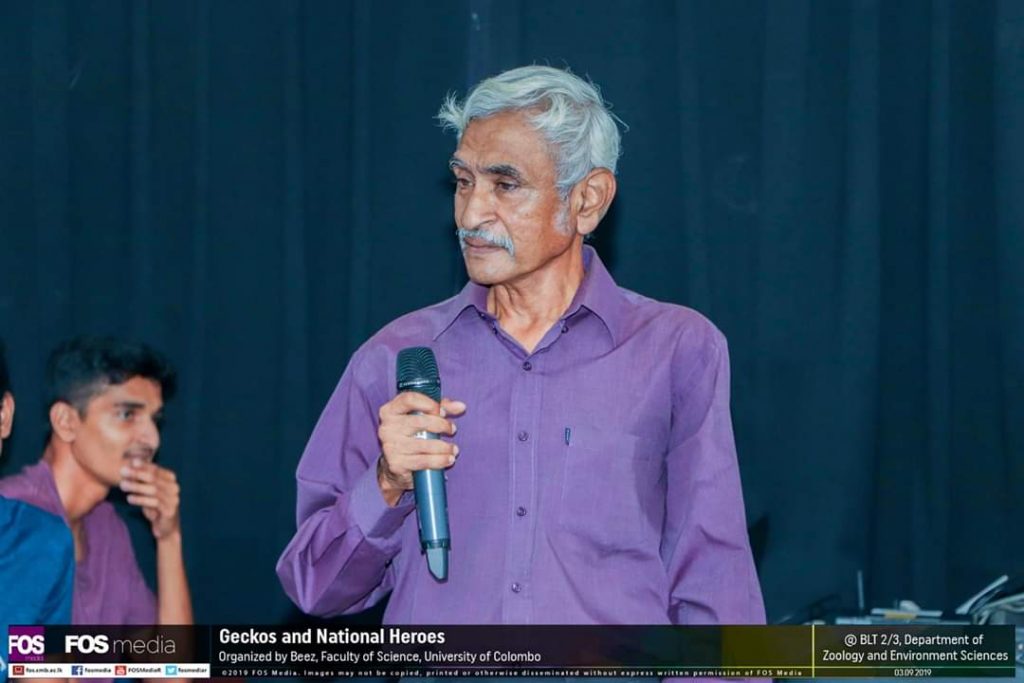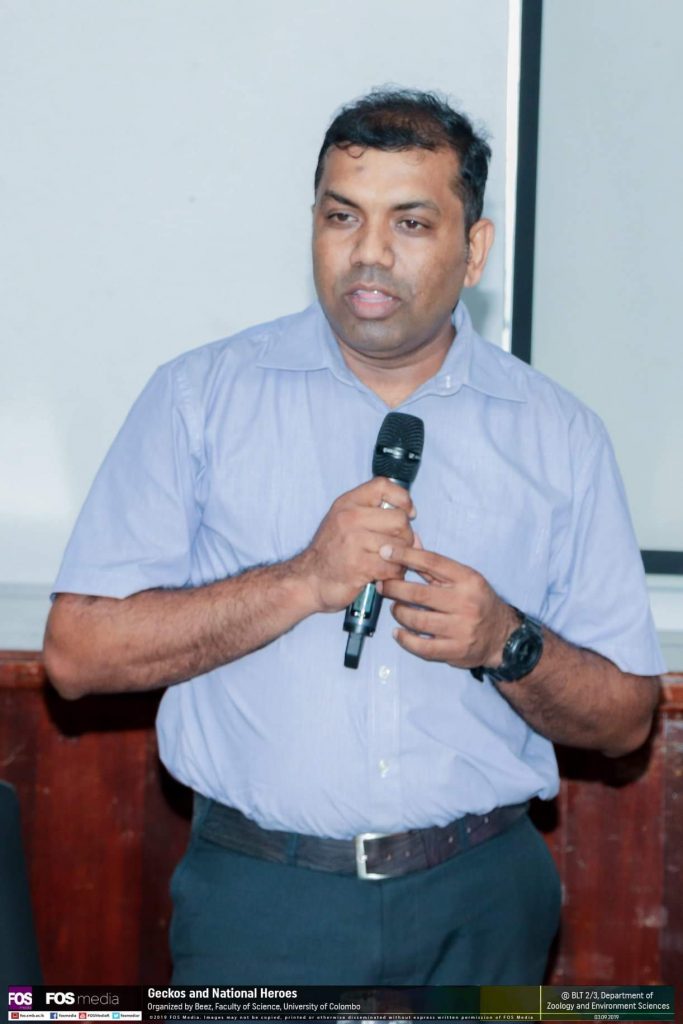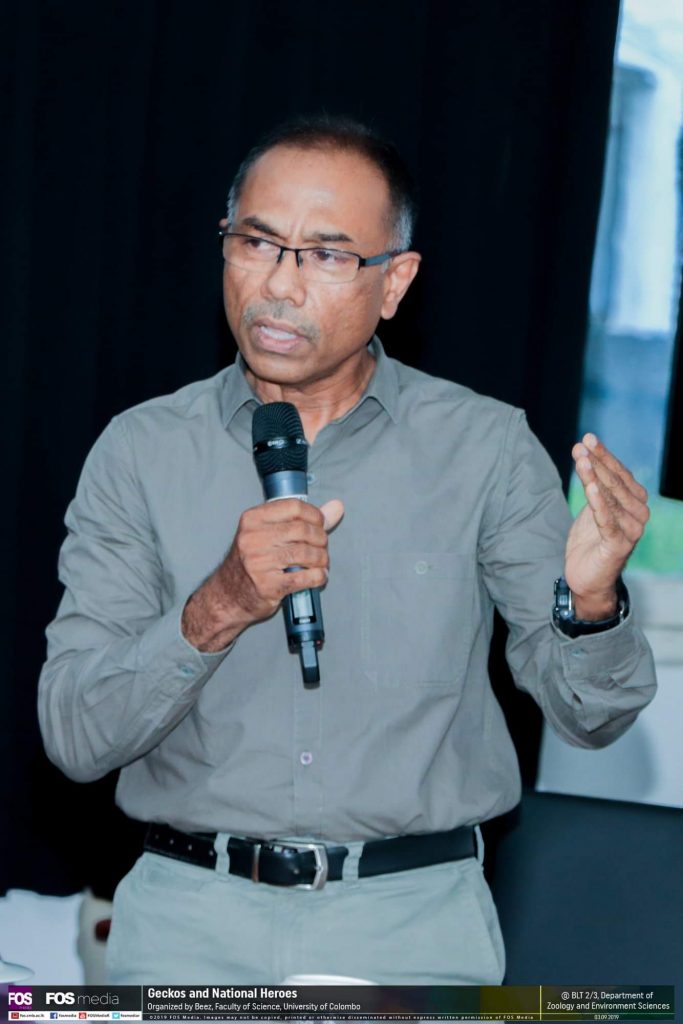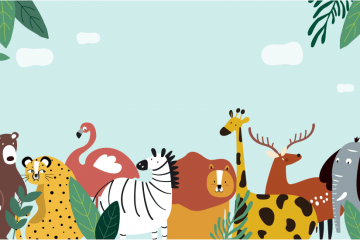Naming of six recently discovered geckos after the past national warriors of Sri Lanka created contentious political and social unrest within the country. The six geckos were discovered by the Sri Lankan Scientist and Herpetologist Mr. Sameera Suranjan Karunaratne along with his team of researchers.
What paved for this controversial discussion, especially in social media, was the naming of these geckos after the national warriors of the country. The 6 geckos are,
- Cnemaspis nandimithrai named after the warrior, Nandimithra, who was 1 of the 10 giant warriors of King Dutugemunu.
- Cnemaspis gotaimbarai named after the warrior, Gotaimbara, who was 1 of the 10 giant warriors of King Dutugemunu.
- Cnemaspis kohukumburai named after, Kohukumbure Walawwe Rate Raala who was a national hero of the Uva Wellassa rebellion from 1817 to 1818.
- Cnemaspis hitihami named after Meegahapitiye Walawwe Hitihami Mudiyanselage Rate Raala
- Cnemaspis butewai named after Butewe Rate Raala
- Cnemaspis kivulegedarai named after Kiuvelegedara Mohottala.

Following the controversial discussions regarding this topic among public and social media, the Base for Enthusiasts of Zoology and Environment Sciences (BEEZ) of Faculty of Science, University of Colombo organized a panel discussion on the 3rd of September 2019 at the faculty premises. The event was attended by lecturers, staff and undergraduates of the faculty as well as outside attendees like school children and other distinguished experts. The objective of the panel discussion was to discuss who is correct and who is not regarding this topic.
The panel for the day included distinguished experts,
- Mr. Jagath Gunawardana, Environmental lawyer
- Mr. Mendis Wickramasinghe, Herpetologist
- Prof. Nihal Dayawansa of Department of Zoology and Environment Sciences, Faculty of Science, University of Colombo
- Prof. K.M Nalin de Silva of Department of Chemistry, Faculty of Science, University of Colombo
- Dr. Hashendra Kathriarachchi of Department of Plant Sciences, Faculty of Science, University of Colombo
- Dr. M.T.M Mahees of Department of Sociology, Faculty of Arts, University of Colombo
Initiating the discussion, Mr. Mendis Wickramasinghe opined that scientific naming of an animal or a plant with a name of a human individual is a well established practice that has been carried out since a long time. He elaborated that it is not an attempt to insult or belittle an individual but rather an attempt to honor and immortalize him or her for the contribution made to his or her respective field.

Speaking as the next panelist Prof. Nalin de Silva stated that Sri Lankans have very poor science knowledge despite their high literacy rates. He blames this on the lack of science journalism in the country which is of utmost importance to convey the scientific findings to the general public. He stressed out that scientific discovery is a strenuous activity in terms of time and effort. In fact herpetologist, Mr. Karunaratne had spent 2 years researching about these lizards in more than 100 locations of the country. Thus, Prof. de Silva is of the opinion that such valuable scientific discoveries should be given the proper due recognition and respect by the public.

Opining as the 3rd panelist Dr. Hashendra Kathriarachchi stated that there is nothing wrong in this naming incident. As a botanist, she mentioned that scientific naming initiated with plants and hence many plants have been named upon several individuals. Rummaging through her memory, she further mentioned that she had not come across any previous controversial incidents related to scientific naming of plants. Nonetheless, she is of the opinion that animals receive more attention than plants with respect to similar incidents thus sparking controversies among the general public.

Mr. Jagath Gunawardana as the 4th panelist captivated the audience with a story that dates back to the British colonial times and which is related to the scientific naming of a Sri Lankan bird called Brown Breasted Flycatcher (Muscicapa muttui). It has been named by the British administration officer Edgar Leopold Layard in honor of his cook “Muttu” who had hunted and brought it to Layard. Reiterating Mr. Wickramasinghe’s opinion, Mr. Gunawardana stated that naming an animal or a plant after an individual is an attempt to immortalize him/her with the pure intention of honoring. Upon being queried on the possibility to file a court case on this incident, Mr. Gunawardana mentioned that it isn’t possible to do so since it is apparent the considered naming incidence had no intention of dishonoring the related individuals. Nonetheless, he further stated that the scientific name can be challenged through a civil case if the related individual or his/her family members file a court case on the grounds of dishonor.

Questing through the history of scientific naming of animals, one can stumble upon many similar examples where they have been named upon distinguished individuals like,
- Singafrotypa mandela, a spider named after Nelson Mandela
- Desmopachria barackobamai, a beetle named after former US president, Barack Obama.
- Eristalis gatesi, a fly named after Bill Gates
- Grouvellinus leonardodicaprioi, a beetle named after the famous actor, Leonardo Dicaprio
Similar examples can be found within Sri Lanka in an attempt to honor the contribution of various distinguished individuals in their respective fields.
- Bufo kotagamai, a frog named after Prof. Emeritus Sarath Kotagama by Prof. Nihal Dayawansa and Dr. Prithiviraj Fernando.
- Pseudophilautus dayawansai, a frog named after Prof. Nihal Dayawansa.
- Pseudophilautus jagathgunawardanai, a frog named after Mr. Jagath Gunawardana by Mr. Mendis Wickramasinghe.
- Aspidurai ravanai, a snake named after the ancient King Ravana, by Mr. Mendis Wickramasinghe.
- Pseudophilautus puranappu, a frog named after the national hero, Weera Puranappu, by Mr. Mendis Wickramasinghe.
As the 5th panelist, Dr. M.T.M. Mahees took over the discussion. As a sociologist, Dr. Mahees points out that the origin of such controversial discussions are fuelled by the varied social and mental aspects of the general public through which they view the incident. He mentioned that the possible reason to ignite this controversy might be because the related animals here are lizards who are considered to be less important in terms of aesthetic and cultural values. He pointed out that the knowledge of the general public is most of the time specific to a certain area and thus they have knowledge of different levels which act as a barrier for comprehension and critical thinking of scientific matters. Citing the example, The Silent Spring by Rachel Carson which was a major hit and an eye opener during the latter part of the 20th century, Mr. Mahees stressed out that it is the role of the science journalists to convey their discoveries to the public in an easily comprehendible manner.

Speaking as the final panelist, Prof.Nihal Dayawansa reminisced his prior experience on discovering the frog Bufo kotagamai, and naming it after Prof. Emeritus Sarath Kotagama as an honor. He further stressed out the importance of urgent conservation of the environment which harbors a wide range of point endemic and endangered animals of Sri Lanka. He also revealed that Maragala Kanda, which is the natural habitat of the Kumarasinghes’s Day Gecko (Cnemaspis kumarasinghei) is facing a dire threat of destruction due to construction activities and the authorities have pathetically chosen to turn a blind eye regarding the whole matter.

Wrapping up the discussion, the panel stated that Sri Lankans lack scientific literacy despite the country being considered to have one of the world’s best literacy rates. They also reiterated that a larger responsibility lies on the shoulders of science journalists on bridging the gap between scientific information and general public. It should be understood that people come from different educational and social platforms, thus the scientific information has to be delivered in a manner that cater their respective platforms. The panel also pointed out that in an era where scientific information is readily available at our finger tips, the public also has a responsibility on searching, learning and verifying scientific information prior to creating and spreading misinformation.
Image courtesy
- 1st content image – https://imgs.mongabay.com/wp-content/uploads/sites/20/2019/08/27151022/nandimithrai-edited.jpg
- 2nd content image – https://imgs.mongabay.com/wp-content/uploads/sites/20/2019/08/27151728/gotaimbarai-1-e1566935261180.jpg
- 3rd content image – https://imgs.mongabay.com/wp-content/uploads/sites/20/2019/08/27155606/Kohu-final-e1566935904393.jpg
- 4th content image – https://imgs.mongabay.com/wp-content/uploads/sites/20/2019/08/27152736/hitihami-e1566936062382.jpg
- 5th content image – https://imgs.mongabay.com/wp-content/uploads/sites/20/2019/08/27161347/butewei-edited-final-1-e1566936862831.jpg
- 6th content image – https://imgs.mongabay.com/wp-content/uploads/sites/20/2019/08/27153320/Kivulei-edited-e1566936436918.jpg
- 7th – 12th content images – FOS Media
References
- Hadunnetti D. (2019a). What’s in a name? For Sri Lanka’s newest geckos, a political firestorm. Mongabay. Retrieved from https://news.mongabay.com/2019/08/whats-in-a-name-for-sri-lankas-newest-geckos-a-political-firestorm/
- Hadunnetti D. (2019b). Sri Lanka scientists stand by naming of new geckos amid nationalist criticism. Mongabay. Retrieved from https://news.mongabay.com/2019/09/sri-lanka-scientists-stand-by-naming-of-new-geckos-amid-nationalist-criticism/
- Karunarathna, S. S., Poyarkov, N. A., De Silva, A., Madawala, M., Botejue, M., Gorin, V. A., & Bauer, A. M. (2019). Integrative taxonomy reveals six new species of day geckos of the genus Cnemaspis Strauch, 1887 (Reptilia: Squamata: Gekkonidae) from geographically-isolated hill forests in Sri Lanka. Vertebrate Zoology, 69(3), 247-298. doi:10.26049/VZ69-3-2019-02
- Wikipedia (2020). List of organisms named after famous people. Retrieved from https://en.wikipedia.org/wiki/List_of_organisms_named_after_famous_people
Written by:

Junior Editor 2019/20
BEEZ



0 Comments